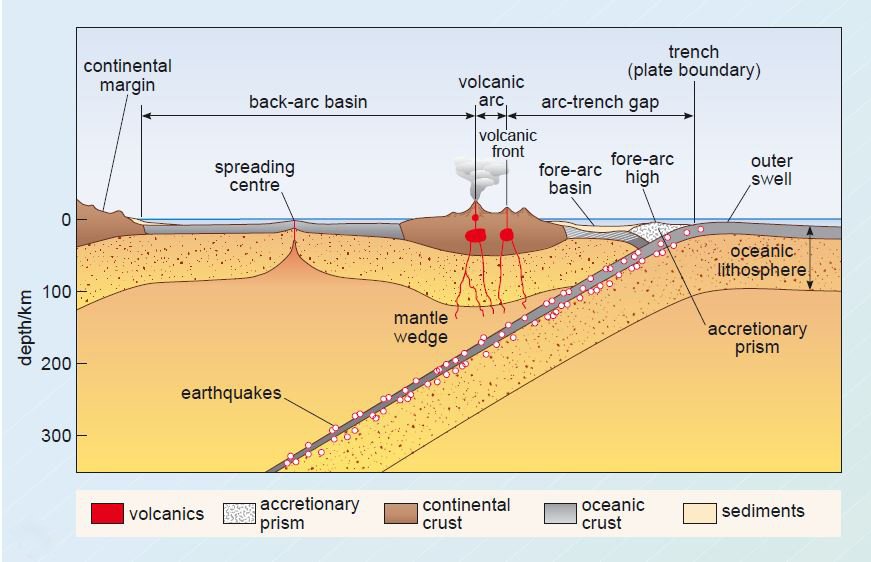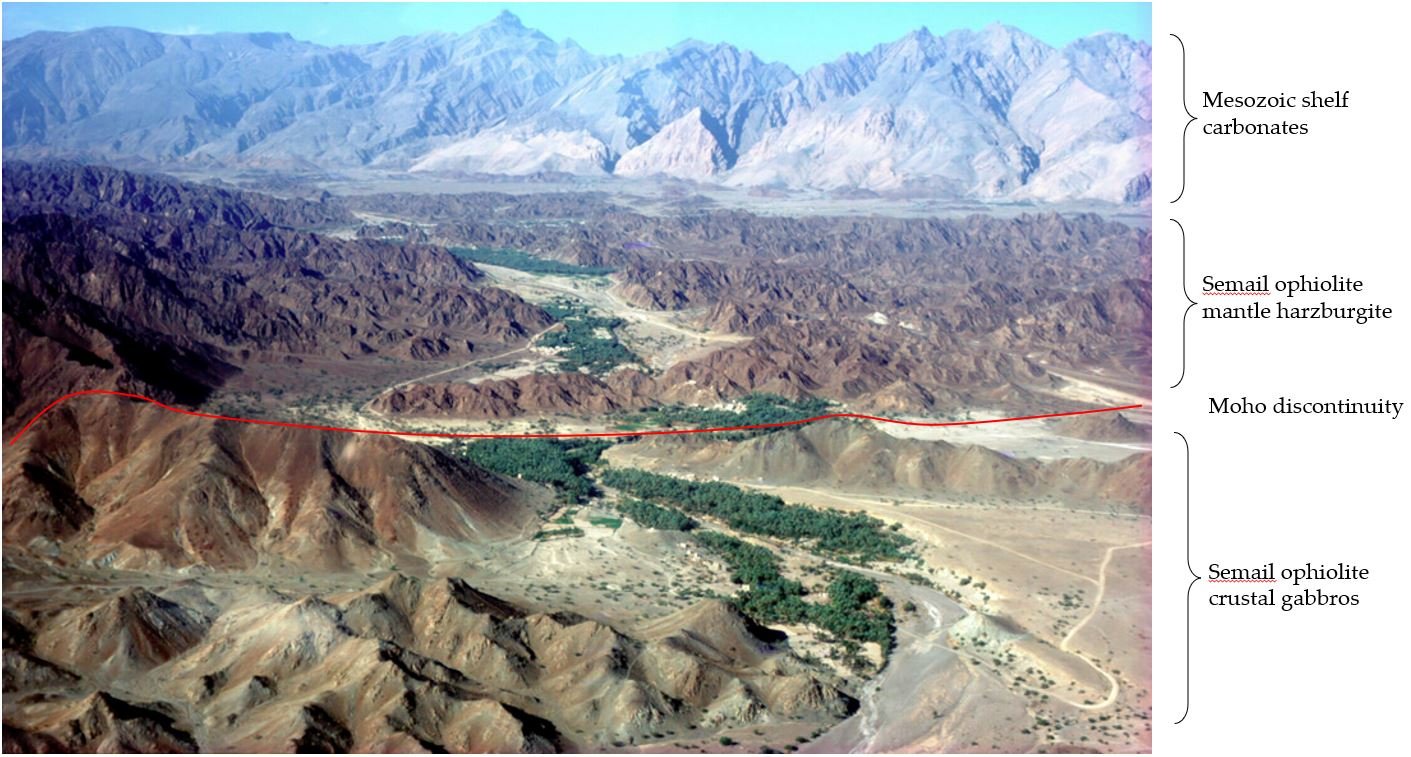Mike Searle on Ophiolite
Listen to the podcast here or wherever you listen to podcasts.
Scroll down for illustrations that support the podcast.
Note - playing the podcast is not supported on Internet Explorer; please use any other browser, or listen on Spotify, Apple Podcasts, etc.
Mike Searle is Emeritus Professor of Earth Sciences at the University of Oxford and at the Camborne School of Mines in Cornwall. In his second Geology Bites appearance in this 50th episode, he describes what ophiolites are, and how they present us with a unique opportunity to see oceanic crust and upper mantle at close quarters. So close, in fact, that in this image, he has his finger on the Moho, the lithological boundary between the crust and mantle in the Semail ophiolite in Oman. He explains the evidence that enabled us to reconstruct the sequence of events that placed the Semail ophiolite on top of the Arabian continental margin.
Photo by Oliver Strimpel
Podcast Illustrations
All illustrations courtesy of Mike Searle unless otherwise indicated.
The Semail Ophiolite in Oman
Landsat satellite image of the Arabian plate. The large yellow swirls in the central and southern regions of the Arabian peninsula are sands in the Empty Quarter covering an area about the size of France. The Oman ophiolite comprises the dark-colored rocks exposed along mountains of northern Oman. DSF = Dead Sea Fault
Image Courtesy of NASA
Geological map of the Oman mountains showing the extent of the Semail ophiolite.
Semail ophiolite “stratigraphy”
Rock succession through the Oman ophiolite with photos illustrating each rock type on the right. The crustal sequence is composed of various types of gabbro. The crust and mantle are separated by the Moho discontinuity, which can be a distinct boundary but is more often a zone of mixed peridotites and gabbros. The mantle sequence is composed of various types of peridotite, such as dunite and harzburgite. At the bottom is a thin slice of metamorphosed oceanic plate rocks called the metamorphic sole.
Subduction Zone Structural Diagrams
Diagrammatic section through an arc system at a subduction zone, showing the relationships between the fore-arc, volcanic (island) arc, and back-arc basin with a back-arc spreading center. As the oceanic lithosphere subducts, dehydration reactions in the subducted basalts release water, causing partial melting of the mantle above, which in turn feeds the volcanism on the upper plate. As discussed in the podcast, the evidence suggests that ophiolites formed at a spreading center in a back-arc basin. The metamorphic sole discussed in the podcast corresponds to the top of the subducting oceanic lithosphere where the earthquake dots are shown. The metamorphism was caused by the exposure to the hot wedge of mantle material that lies immediately above it.
Courtesy of the Open University, © Open University 2013
In the podcast, Mike Searle describes the evidence that supports this model for the formation of the ophiolite rocks. Radiometric dating of the ophiolite and of the metamorphic sole reveal that they were formed simultaneously. The metamorphic sole is the purple-shaded layer (amphibolite sole). The inverted metamorphism of the sole is explained by heating of the subducting oceanic lithosphere by the hot wedge-shaped mantle material lying above it. The trace element geochemistry matched the ophiolite with lavas formed in island arcs and back-arc spreading centers, as depicted here. In the case of the Semail ophiolite, though, the erupted lavas consist only of pillow lavas formed under water, since the erupted volume was not sufficient to reach the ocean surface and form the volcanos of an island arc.
The subduction zone initiated in the middle of the Tethys ocean about 95 million years ago. After about 15 million years of subduction, i.e., at 80 million years ago, the Arabian continental margin arrived at the subduction zone trench from the southwest (i.e., the left side of the figure), and its leading edge was pulled down to a depth of about 100 km, causing the overriding oceanic plate to be obducted onto Arabia. This is the mechanism of ophiolite emplacement. After the subducted oceanic slab broke off, the subducted continental rocks, which are much less dense than the mantle, “floated” back up to the surface, where they appear today, for example as the coastal eclogites at As Sifah described in the podcast.
Aerial view of the Oman ophiolite. The ophiolite has been thrust over the Mesozoic limestones of the Arabian plate margin seen in the distant mountains. The carbonate minerals of the limestones weather much more slowly than the olivine and pyroxene of the mantle harzburgite, which is why they are topographically much higher than the ophiolite.
Highly eroded mantle peridotite sequence of the Semail ophiolite. In the podcast, Mike Searle describes this “Lord of the Rings” landscape, and how he often scratched his knees while scrambling over these very crumbly rocks. They have survived being eroded away completely only by virtue of the extremely dry desert climate.
The mantle portion of the ophiolite is composed mainly of harzburgite, a variety of peridotite largely composed of the minerals olivine and clinopyroxene. In dry climates, olivine weathers to form a brown crumbly material.
Photo by Oliver Strimpel
The sequence from the metamorphic sole (left) to the lowermost layer of the ophiolite (right). The metamorphic sole comprises rocks of the Triassic-Jurassic oceanic lithosphere that have been metamorphosed by the overlying mantle as they subducted at depths of 38-45 km. The metamorphism is inverted, with the highest-grade metamorphic rocks on top (garnet & clinopyroxene amphibolite) and the lowest-grade metamorphic rocks on the left (marble and quartzite).
Mike Searle among the giant pillow lavas of the upper crust of the Semail ophiolite. As explained in the podcast, the lavas were formed above a subduction zone that was active 96-80 million years ago in the Tethys ocean. The pillows erupted underwater, causing them to cool rapidly and form the characteristic nested pillow shapes. The lava did not build up sufficiently to rise above the surface and form the volcanos that constitute the island arcs commonly produced above subduction zones.
Photo by Oliver Strimpel
Eclogites at As Sifah
As Sifah eclogite beach, showing the dark-colored eclogites beneath pale-colored metamorphosed Permian limestones. The eclogites are ultra-high-pressure rocks exhumed from a depth of about 100 km after the subducting oceanic slab is thought to have broken off, releasing these lighter continental rocks to return to the surface.
The As Sifah eclogite beach at high tide.
Photo by Oliver Strimpel
The eclogites contain giant garnets (dark spherical minerals), as well as blue glaucophane (a sodic amphibole), and green pyroxenes. The metamorphic petrology indicated that metamorphism peaked at a depth of about 100 km.
Photo by Oliver Strimpel
A sample of the eclogite studded with dark garnets.
Photo by Oliver Strimpel
Oman GeoPark Proposal
As mentioned in the podcast, Mike Searle has promulgated a proposal for a set of GeoParks to protect and highlight the extraordinary geology on display in Oman.
Landsat image of Oman with box indicating the region covered in the map below.
Landsat image of northern Oman showing locations of proposed GeoParks in northern Oman. The As Sifah eclogites are shown just south of Muscat as park number 4.
Further Reading
Searle, M (2019), Geology of the Oman Mountains, Eastern Arabia, Springer
Searle, M (2014), Preserving Oman’s geological heritage: proposal for establishment of World Heritage Sites, National GeoParks and Sites of Special Scientific Interest (SSSI), in Tectonic Evolution of the Oman Mountains, Geol. Soc., London, Special Publications, 392, 9
Cowan et al. (2014), in Tectonic Evolution of the Oman Mountains, Rollinson et al. (eds.), Geol. Soc., London, Special Publication, 392, 155
Detailed Reading List
Agard, P. et al (2010) Crustal stacking and expulsion tectonics during continental subduction: P‐T deformation constraints from Oman, Tectonics, 29 TC5018 1-19
Glennie, K.W. et al. (1973) Late Cretaceous nappes in Oman Mountains and their geologic evolution. American Association of Petroleum Geologists Bulletin, 57, 5-27
Lippard, S.J. et al. (1986) The Ophiolite of Northern Oman, Geological Society, London, Memoir, 11
Pearce, J.A., et al. (1981) The Oman ophiolite as a Cretaceous arc-basin complex: evidence and implications, Philosophical Transactions of the Royal Society, London, A300, 299-317
Rioux, M. et al. (2021) High-precision U-Pb zircon dating of late magmatism in the Semail Ophiolite: A record of subduction initiation, Journal of Geophysical Research Solid Earth, 126
Searle, M. (2007) Structural geometry, style and timing of deformation in the Hawasina Window, Al Jabal al Akhdar and Saih Hatat culminations, Oman Mountains, GeoArabia, 12, (2), 99-132
Searle, M. et al. (1999) Tectonic setting, origin and obduction of the Oman Ophiolite, Geological Society of America Bulletin, 111, 104-122
Searle, M. et al. (2004) Structural evolution, metamorphism and restoration of the Arabian continental margin, Saih Hatat region, Oman Mountains, Journal of Structural Geology, 26(3), 451-473
Searle, M. et al. (2014) Tectonics of the Musandam peninsula and northern Oman Mountains: From ophiolite obduction to continental collision, GeoArabia 19(2), 135-174
Searle, M.et al. (2015) Structure and metamorphism beneath the obducting Oman Ophiolite, Geosphere, 11(6), 1812-1836
Soret, M., et al. (2016) Petrological evidence for stepwise accretion of metamorphic soles during subduction infancy (Semail ophiolite, Oman and UAE), Journal of Metamorphic Geology, doi:10.1111/jmg.12267
Warren, C.J., et al. (2003) Dating the subduction of the Arabian continental margin beneath the Oman ophiolite, Geology, 31, 889-892

















